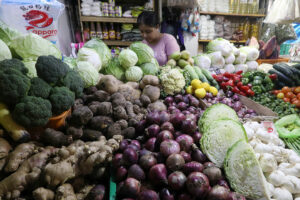Inflation sizzles to 14-year high of 8% in November

RISING FOOD PRICES pushed inflation to a 14-year high in November, the Philippine Statistics Authority (PSA) said on Tuesday.
Preliminary data from the Philippine Statistics Authority (PSA) showed headline inflation accelerated 8% in November, the most since the 9.1% print during the Global Financial Crisis in November 2008.
The latest print was faster than the 7.7% in October, and 3.7% in November 2021. It was also higher than the median estimate of 7.8% in a BusinessWorld poll of 15 analysts conducted last week, but within the 7.4-8.2% forecast range of the Bangko Sentral ng Pilipinas (BSP).
November inflation also breached the BSP’s 2-4% target range for an eighth straight month.
President Ferdinand R. Marcos, Jr. on Tuesday said that while the economic growth is healthy, inflation is “running rampant and out of control.”
“The main drivers of that inflation, unfortunately, are still imported… So again, import substitution is still a good idea not only for foreign exchange reserves but also so that we can keep our inflation rate down,” he said in a speech at the Arangkada Philippines Forum after the release of inflation data.
For the January-to-November period, inflation averaged 5.6%, faster than the 4% in the same period a year ago. However, this was still below the BSP’s full-year forecast of 5.8%.
Month on month, the consumer price index (CPI) inched up by 0.9%. Stripping out the seasonality effects on prices, inflation dipped 0.7% in November from October’s 1%.
Core inflation, which discounts volatile prices of food and fuel, climbed 6.5% in November from 5.9% in October and 2.4% in November 2021. In the eleven months to November, core inflation averaged 3.7%.
Divina Gracia L. Del Prado, PSA officer-in-charge and deputy national statistician, said at a briefing that November inflation quickened due to the spike in food prices, which reflected the spillover effect of the typhoon that hit the country in late October. Severe Tropical Storm Paeng (international name: Nalgae) that caused about P6.4 billion in agricultural damage.
The heavily-weighted food and non-alcoholic beverages index rose 10% in November, from 9.4% in the previous month. This was the fastest rise in food inflation since September 2018.
“Higher prices of vegetables, fruits, and rice were a result of lower production brought about by the onslaught of typhoons and higher cost of inputs. Similarly, sugar production is still reeling from the damage caused by recent typhoons,” the National Economic and Development Authority (NEDA) said in a separate statement.
Vegetable inflation surged 25.8% in November (from 16% in October), while sugar, confectionery and desserts rose 38% (from 34.4% in October). Rice prices went up 3.1%, from 2.5% in the previous month.
Another driver of November inflation was the restaurants and accommodation services index, which jumped 6.5% in November, from 5.7% in the prior month, reflecting continued “revenge spending” by Filipinos.
Out of 13 commodity groups, 10 reported faster inflation in November, including alcoholic beverages (10.6% from 10.4% in October), clothing and footwear (3.6% from 3.1%), furnishings and household equipment (4.5% from 3.8%) and health (2.8% from 2.6%).
On the other hand, slower rates of increases were seen in housing, water, electricity, gas and other fuels (6.9% from 7.4% in October); and transport (12.3% from 12.5%).
Ms. Del Prado said the rise in pump prices started to slow in November.
“Inflation is decelerating for petroleum products. So, if we see the effects of food prices (slow down), that might decrease (overall) inflation,” she said in a mix of English and Tagalog.
PSA data showed inflation for the bottom 30% income households, which still use the 2012-based prices, rose to 7.7% in November — the highest since October 2018. This was faster than the 7.3% print in October and 4.2% last year.
For the 11-month period, the average inflation for this income group stood at 5.1%.
“The government is continuously implementing targeted subsidies and discounts to allay the impact of the higher prices of essential goods, especially for the vulnerable sectors and low-income earners of our society,” Socioeconomic Planning Secretary and NEDA chief Arsenio M. Balisacan said in a statement.
Inflation in the National Capital Region (NCR) decelerated to 7.5% in November, from 7.7% in October and 2.2% a year ago.
Outside of NCR, consumer prices rose 8%, from 7.6% in October and 4% in the same month of 2021.
INFLATION TO SLOWMs. Del Prado said inflation can rise as much as 8.5% in December to hit the BSP’s full-year forecast of 5.8%.
“If headline (inflation) is lower than that, then average inflation for the year should also be lower,” she said, adding that inflation does not always peak in December.
The Development Budget Coordination Committee (DBCC) on Monday also raised its average inflation rate assumption to 5.8% this year, from 4.5-5.5%.
“Inflation is projected to decelerate in the subsequent months due to easing global oil and non-oil prices, negative base effects, and as the impact of BSP’s cumulative policy rate adjustments work its way to the economy,” the central bank said in a statement.
The BSP maintained it “remains prepared to take all further monetary policy actions necessary to bring inflation back to a target-consistent path over the medium term.”
The BSP has raised the key policy rate by 300 basis points (bps) to 5% since May to curb soaring inflation. The Monetary Board’s last policy review meeting for the year is on Dec. 15.
Finance Secretary Benjamin E. Diokno said in a separate statement that inflation is expected to ease by the second half of 2023, averaging between 2.5-4.5%.
Bank of the Philippine Islands Lead Economist Emilio S. Neri, Jr. said the November inflation print showed that food continues to drive inflation higher amid supply issues in the agriculture sector and the impact of recent typhoons.
“Distribution of food products remains expensive given the elevated price of oil… Even if oil prices have stabilized recently, the pressure on consumer prices may not ease until the second half of 2023,” he said in a note.
Despite the faster November print, Mr. Neri said inflation may be nearing its peak.
“We expect a decline in the coming months mainly due to the stabilization of oil prices recently,” he said. “Given the outlook for inflation, there is a compelling reason for the BSP to continue hiking interest rates.”
In a note on Tuesday, ING Bank N.V. Manila Senior Economist Nicholas Antonio T. Mapa said headline inflation could still peak in December and slow in January, but inflation will not decelerate quickly similar to what happened in 2018.
“We do believe inflation will grind lower and not repeat the quick deceleration we saw in 2018. High inflation has ‘infected’ roughly 60% of the CPI basket showing us that price pressures are now more broad-based,” he added.
Mr. Mapa said the BSP will likely remain hawkish at its meeting next week.
“Demand-side pressures remain evident after items related to ‘revenge spending’ experienced quicker inflation. Thus, we expect BSP to carry out a 50-bp increase next week or matching any rate increase by the Fed,” Mr. Mapa said. — Keisha B. Ta-asan




